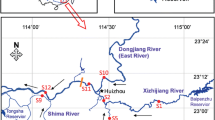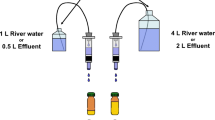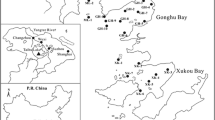Abstract
Goal, Scope and Background
Exogenic endocrine-active substances are also called ‘Endocrine Disrupting Chemicals’ (EDC). They imitate or hinder the function of natural endogenic hormones or disturb the synthesis or the metabolism of hormones or of hormone receptors. The Enzyme-Linked Receptor Assay (ELRA) can detect estrogenic and anti-estrogenic effects at the level of receptor binding and is a useful tool for the integrative detection of contaminant effects. Although the test system has been used repeatedly in sediment assessments, the questions have remained concerning how it responds to variations in the physico-chemical matrix. For some bioassays, the salinity of the sample is a critical factor. This is especially relevant when testing wastewater samples or when sediment-associated samples in the tidal reaches of rivers are tested. Sediments in the tidal reaches of rivers change their salinity several times a day. Against this background, it would be beneficial to have a test procedure of known salinity tolerance. On account of this, the salinity tolerance of the ELRA was tested, assessed with reference substances at several salinity levels, and compared with the E-Screen method and a Yeast Estrogen Screen (YES), which are also frequently applied in environmental testing. The aim of this paper was to explore when the salinity limits within these test procedures are applicable. The trials should reveal the working range to be expected, characterize the salinity-dependent variations in sensitivity of the test, and provide options for methodological adjustments to improve the stability against increased salinity.
Methods
The ELRA was carried out with the human Estrogen Receptor α. (ER) using the same principle like a competitive immunoassay based on ligand-protein interaction. However, an essential difference is the use of a physiologically relevant receptor instead of an antibody as a linking protein. The ELRA measures the competition of sample estrogens and anti-estrogens against estradiol supplied as a BSA-coating conjugate for the binding site of dissolved ER. Estradiol or xeno-estrogen binding is quantified by a biotynilated anti-ER antibody and the subsequent measurement of peroxidase activity by a streptavidin-POD-biotin complex. The E-Screen was performed with the human breast cancer cell line MCF-7, which expresses the estrogen receptor constitutively. Cell proliferation depends on binding of estrogens or xeno-estrogens with the receptor. After incubation, estrogen-dependent cell growth was measured by sulforhodamin B staining. The YES was performed with a recombinant yeast strain, transfected with a receptor and a reporter plasmid bearing the estrogen receptor and a vitellogenin gene fused with the reporter gene lacZ. Estrogen or xeno-estrogen-dependent gene induction was measured indirectly by LacZ activity. The salinity levels were simulated in varying concentrations with NaCl from 0 to 40‰ or Artificial Sea Water (ASW) from 0 to 32‰.
Results
The study characterized the factor ‘salinity’ for the prospective application fields of the ELRA. With reference substances such as 17-β-estradiol, the ELRA showed classical sigmoidal concentration-effect relations in a range from 0.05 to 100 μg/l under physiological conditions. After a methodological adjustment to compensate decreasing receptor-binding affinity of estrogens and xeno-estrogens at higher salinity levels. the ELRA became applicable under salinity conditions up to concentrations of 20.5‰. In tests, the ELRA reached under the influence of salinity a mean limit of detection of 0.062 βg/l 17-β-estradiol. The mean relative inter-test error was around 11%. Above concentrations of 20.5‰ there is a risk of false negative assessment. Compared with the E-Screen method using the MCF7 cell line and the yeast estrogen test system (YES), the ELRA shows a lower sensitivity to 17-β-estradiol. In the E-Screen, the cell proliferation was strongly reduced by sodium chloride induced cytotoxicity. In comparison with the E-Screen, the salinity tolerance of the YES and YAS methods is significantly higher.
Discussion
Despite adaption, total salinity tolerance could not be achieved with the ELRA. Freshwater samples were generally appraisable. Higher salinity levels above 20.5‰ would tend towards false negative results. The low inter-test error of 11% makes the ELRA suitable for the detection of estrogenic and anti-estrogenic potentials of single substances, substance mixtures, and of environmental samples.
Conclusions
The ELRA is very fast and reproducible, it can be used for high-throughput screening in a microplate format at low cost, it is robust to microbial contamination, and is less susceptible to cytotoxic interferences than cell culture methods.
Recommendations and Perspectives
In their established form, the YES and the E-Screen methods are not applicable for liquid phase testing at higher salinity conditions. The salinity-adapted test version of the ELRA described here shows a broader working range for samples. Native water samples of more or less brackish origin or high-salinity effluent samples are testable. Results of tests with sediment associated samples of different salinity will be subject of a forthcoming publication.
Similar content being viewed by others
References
Sonnenschein C, Soto AM (1998): An updated review of environmental estrogen and androgen mimics and antagonists. Steroid Biochem Mol Biol 65, 143–150
Guillette LJJ, Gross TS, Mason GR, Matter JM, Percival HF, Woodward AR (1994): Developmental abnormalities of the gonad and abnormal sex-hormone concentrations in juvenile alligators from contaminated and control lakes in Florida. Environ Health Perspect 102, 680–688
Fox GA (2001): Effects of Endocrine Disrupting Chemicals on Wildlife in Canada: Past, Present and Future. Water Qual Res J Canada 36(2) 233–251
Ankley G, Mihaich E, Stahl R, Tillitt D, Colborn T, McMaster S, Miller R, Bantle J, Campbell P, Denslow N, Dickerson R, Folmar L, Fry M, Giesy J, Gray E, Guiney P, Hutchinson T, Kennedy S, Kramer V, LeBlanc G, Mayes M, Nimrod A, Patino R, Peterson R, Purdy R, Ringer R, Thomas P, Touart L, van der Kraak G, Zacharewski T (1998): Overview of a workshop on screening methods for detecting potential (anti-)estrogenic/androgenic chemicals in wildlife. Environ Toxicol and Chem 17(1) 68–87
Blaise C, Gagne F, Salazar M, Salazar S, Trottier S, Hansen PD (2003): Experimentally-induced feminisation of freshwater mussels after long-term exposure to a municipal effluent. Fresenius Environmental Bullentin by PSP 12(8) 865–870
Länge R, Hutchinson TH, Croudace CP, Siegmund F, Schweinfurth H, Hampe P, Pante, GH, Sumpter JP (2001): Effects of the synthetic estrogen 17-α-ethinylestradiol on the life-circle of the fathead minnow (Pimephales promelas). Environ Toxicol and Chem 20(6) 1216–1227
Lutz I, Kloas W (1999): Amphibians as a model to study endocrine disruptors: l. Environmetal pollution and estrogen receptor binding. The Science of the Total Environment 225(1–2) 49–57
Lutz I, Kloas W, Einspanier R (1999): Amphibians as a model to study endocrine disruptors: II. Estrogenic activity of environmental chemicals in vitro and in vivo. Sci Total Environ 225(1–2) 59–68
Stifani S, George R, Schneider WJ (1988): Solubilization and characterization of the chicken oocyte vitellogenin receptor. Biochem J 250, 467–475
Eroschenko VP, Palmiter RD (1980): Estrogenicity of kepone in birds and mammals. In: McLachlan JA (ed), Estrogens in the Environment. Elsevier NY, USA, 305–325
Seibert H (1996): Störungen der Entwicklung und Funktion des männlichen Reproduktionssystems. UWSF — Z Umweltchem Ökotox 8(5) 275–284
Seifert M (1999): Bestimmung von Oestrogenen und Xenooestrogenen mit einem Rezeptorassay. Dissertation zur Erlangung des Grades eines Doktors der Naturwissenschaften an der Technischen Universität München
Seifert M, Haindl S, Hock B (1998): In vitro analysis of xenoestrogens by enzyme linked receptor assays (ELRA) Adv Exp Med Biol 444, 113–117
Seifert M (2003): Luminescent enzyme linked receptor assay for estrogenic compounds. Anal Bioanal Chem 378(3) 684–687
Seifert M, Haindl S, Hock B (1999): Development of an enzyme linked receptor assay (ELRA) for estrogens and xenoestrogens. Elsevier: Anal Chim Acta 386, 191–199
ISO 10253 (2006): Water quality — Marine algal growth inhibition test with Skeletonema costatum and Phaeodactylum tricornutum
McDonnell DP, Nawaz Z, Densmore C, Weigel NL, Pham TA, Clark JH, O’Malley BW (1991): High level expression of biologically active estrogen receptor in Saccharomyces cerevisiae. J Steroid Biochem Mol Biol 39(3) 291–297
Soule HD, Vazquez J, Long A, Albert S, Brennan MJ (1973): A human cell line from a pleural effusion derived from a breast carcinoma. J Natl Cancer Inst 51, 1409–1413
Soto AM, Sonnenschein C, Chung KL, Fernandez MF, Olea N, Serrano FO (1995): The E-SCREEN assay as a tool to identify estrogens: An update on estrogenic environmental pollutants. Environ Health Perspect 103(7) 113–22
Reifferscheid G, Heil J, Oda Y, Zahn RK (1991): A microplate version of the SOS/umu-test for rapid detection of genotoxins and genotoxic potentials of environmental samples. Mutation Res 253 215–222
DIN 38415-6 (2003): Deutsche Einheitsverfahren zur Wasser-, Abwasser-und Schlammbehandlung — Suborganismische Testverfahren (Gruppe T) — Teil 6: Giftigkeit gegenüber Fischen, Bestimmung der nicht akut giftigen Wirkung von Abwasser auf die Entwicklung von Fischeiern über Verdünnungsstufen (T6)
Rodbard D (1971): Statistical aspect of radioimmunoassay. In: Odell WD, Daughaday JB, Lipincott JB (eds), Competitive protein binding assays. Philadelphia, pp 204–259
Rodbard D, Hutt DM (1974): Statistical analysis of radioimmunoassays and immunoradiometric (labelled antibody) assay: A generalized weighted, iterative, least squares method for logistic curve fitting. Radio-immunoassay and related procedures in Medicine 1, 165–192
Dizer H, Fischer B, Sepulveda l, Loffredo E, Senesi N, Santana F, Hansen PD (2001/2002): Estrogenic effect of leachates and soil extracts from lysimeters spiked with sewage sludge and reference endocrine disrupters. Wiley Periodicals Inc, pp 105–112
Huschek G, Hansen PD (2005): Ecotoxicological classification of the Berlin River System using Bioassays in respect to the European Water Framework Directive. Environ Monit Assess 121(1–3) 15–31
Calmano W (2001): Untersuchung und Bewertung von Sedimenten. Springer-Verlag Berlin Heidelberg, ISBN 3-540-42157-2
Li W, Seifert M, Xu Y, Hock B (2004): Comparative study of estrogenic potencies of estradiol, tamoxifen, bisphenol-A and resveratrol with two in vitro assays. Environ Int 30(3) 329–335
Author information
Authors and Affiliations
Corresponding author
Additional information
ESS-Submission Editor: Dr. Jan Schwarzbauer (schwarzbauer@lek.rwth-aachen.de)
Rights and permissions
About this article
Cite this article
Kase, R., Hansen, PD., Fischer, B. et al. Integral assessment of estrogenic potentials of sediment-associated samples. Environ Sci Pollut Res 15, 75–83 (2008). https://doi.org/10.1065/espr2007.06.429
Received:
Accepted:
Published:
Issue Date:
DOI: https://doi.org/10.1065/espr2007.06.429




